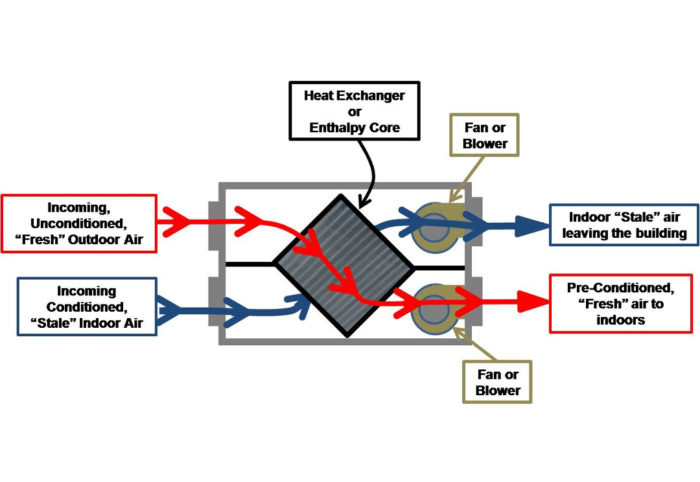Understanding HRV: A Complete Overview
Discovering the Conveniences of Heat Recovery Ventilation for Power Performance in Residences
Heat Recovery Ventilation (HRV) systems supply home owners a practical technique to improving energy efficiency. By reclaiming warmth from outbound air, these systems can considerably reduce home heating and air conditioning prices. Furthermore, they provide a consistent supply of fresh air, enhancing indoor air top quality and convenience degrees. As home owners think about lasting options, understanding the nuances of HRV systems comes to be progressively vital. What elements should one evaluate prior to making such an investment?
Recognizing Heat Recovery Ventilation Systems

How HRV Boosts Indoor Air High Quality

Energy Cost Savings: The Monetary Benefits of HRV
Making best use of energy efficiency, heat recovery ventilation (HRV) systems offer significant financial advantages for homeowners. By recovering and recycling heat from exhaust air, HRVs considerably decrease heating & cooling expenses. This innovation can cause power cost savings of as much as 30%, relying on environment and use patterns. Property owners typically notice reduced energy costs quickly after installation, making HRVs a monetarily sensible investment over time. Furthermore, many areas provide incentives or rebates for energy-efficient upgrades, better improving the financial allure. As energy rates remain to rise, the cost-effectiveness of HRVs ends up being increasingly clear. In general, the unification of HRV systems not only promotes power performance but additionally contributes to long-lasting financial savings for homes.
The Environmental Influence of Heat Recovery Ventilation
A considerable ecological advantage of heat recovery ventilation (HRV) systems lies in their Read Full Report capability to reduce overall energy consumption. By recovering warmth from exhaust air and transferring it to incoming fresh air, HRV systems minimize the demand for energy-intensive home heating and cooling down techniques. This reduction in power need adds to decrease greenhouse gas exhausts, as less fossil gas is called for to preserve comfy indoor temperatures. Furthermore, HRV systems enhance indoor air high quality by successfully trading stagnant air with fresh outdoor air, lowering dependence on mechanical air conditioning systems that can hurt the setting. On the whole, the application of HRV systems supports sustainable living methods and straightens with worldwide efforts to combat environment adjustment by advertising energy effectiveness in top article domestic setups.
Choosing the Right HRV System for Your Home
Just how can property owners guarantee they select the best heat recovery ventilation (HRV) system for their needs? First, they must analyze their home's size and layout, as these factors influence air movement requirements. Next off, evaluating the system's performance scores is crucial, as higher ratings show much better performance and energy savings. Property owners must likewise think about setup and maintenance prices, contrasting various brands and versions for value. In addition, it's essential to assess noise degrees, as some systems operate more quietly than others. Consulting with HVAC specialists can supply tailored suggestions based on specific home problems. Checking out user testimonials and guarantees can aid in making an educated choice, ensuring that the chosen HRV system successfully boosts interior air high quality and power effectiveness.
Regularly Asked Inquiries

Just how Commonly Should I Clean or Preserve My HRV System?
The frequency of cleansing or preserving a heat healing air flow (HRV) system usually depends on use and environmental factors. Normally, it is advisable to do maintenance every 6 months to ensure peak performance and air high quality.

Can HRV Systems Assist Reduce Humidity Levels Inside?
HRV systems can efficiently lower indoor moisture degrees by exchanging stale, humid air with fresh, drier air from outside. HRV Heat Recovery Ventilation. This procedure helps preserve a well balanced indoor atmosphere, boosting convenience and avoiding moisture-related issues
What Is the Lifespan of a Regular HRV System?
The life expectancy of a normal heat recovery ventilation (HRV) system varies, typically lasting in between 10 to 15 years. Routine maintenance can expand its effectiveness and operational life, making certain peak performance throughout its usage period.
Are There Any Noise Interest In HRV Equipments?
Sound interest in HRV systems can develop, specifically from fan procedure. Nonetheless, many modern units are created to reduce sound degrees, guaranteeing they operate silently while maintaining effectiveness, which attends to prospective disturbances important link in living settings.
Can I Set Up an HRV System Myself, or Do I Need an Expert?
The private contemplated whether to mount the heat recovery ventilation (HRV) system directly or work with a specialist. Normally, while DIY setup is feasible, proficiency assurances proper functionality and compliance with neighborhood structure codes, improving system performance.